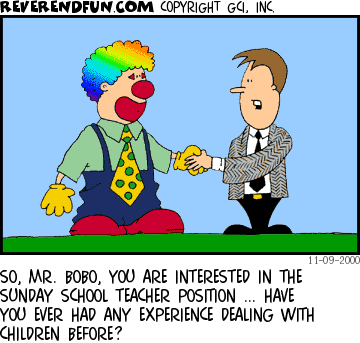
Welcome to a continuing series of tips on working with large groups of children. I hope that you will find these tips useful and be able to implement them in your dealings with large groups of kids. If you do, please leave a comment and let us know. For a complete list of posts in this series, please see the index page. So, without further introduction, here is today’s installment.
In the last installment in this series, we discussed adding a time of questions and answers at the end of each lesson. This is a great way to find out what your kids are really wondering and thinking about. But, questions are a two-way street, and you should also ask questions regularly as part of your large group lesson. In addition to giving kids a chance to speak during the lesson, which will help to discourage talking when it isn’t appropriate, asking questions allows you to discern whether or not the kids truly understand what you are trying to teach.
There are three types of questions you can incorporate into your lesson. The first type of question is the factual question. There is a right answer to these types of questions. For example, at the kindergarten and first grade level when I mention a book of the Bible, I generally ask whether that book is from the Old or the New Testament. This helps the kids to understand how to navigate their way around the Bible. During our December series, I asked where Jesus was born, who his parents were, who appeared to Mary to tell her she was pregnant and various other questions. These types of factual questions help to break up the monotony of one person speaking the whole time. They are also helpful in ascertaining the level and retention of knowledge the kids have.
The second type of question is the “closed-ended questions.” Closed-ended questions can be answered either yes or no. Frankly, I don’t find much use for these in the context of Children’s Ministry. It’s not that there is never a time for “yes/no” questions, but I find the other two types of questions much more useful and revealing. Some people include factual questions in the grouping of closed-ended questions and define the category as questions which require short, oftentimes one word, answers. However, I prefer to think of questions in terms of these three categories as presented.
The final type of question is the “open-ended question.” Open-ended questions solicit additional information from the person being asked the question. These questions are broader in nature than the first two types and generally require longer responses. They include questions like:
- What do you think of that?
- Why do you think Rehoboam chose to take the advice of his friends rather than the elders?
- What would you have done in that situation?
- If you were Peter and saw Jesus walking on water, what would you have done?
- How does that story make you feel?
- How can you shine the light of Jesus into someone’s life this week?
They are the “what would you do…” and “why do you think…” and “how would you…” type questions that probe further into the thoughts and opinions of the students. They require a lot more thought and internal processing in order to answer them, and they require that the student be much more engaged in the conversation. It is a lot easier to fake your way through a yes/no or factual question than an open-ended question.
Several months ago, I wrote an article titled 22 Ways to Teach Kids HOW to Think And Not Just WHAT to Think which discuss numerous ways to get the kids in your classroom thinking. Open-ended questions are included as one way to accomplish that objective. Oftentimes, the answer to one open-ended question may lead to a series of additional questions. However, when you are planning your lesson, you should always come with several open ended questions you could ask even if you never actually get to answer them. That way you will be prepared to engage the student in questioning should the opportunity arise. Furthermore, thinking through your own answers to those open-ended questions will help you to prepare for your lesson.
When you incorporate open-ended questions into your lesson, it is critical that you remain flexible and open-minded. You never know what kids might come up with in response to one of your questions, and you never know when they are just going to draw a blank and have nothing to say. When you engage in open-ended questioning, you must be prepared to encourage kids in their answers without giving them the answer.
So, what do you think of that? How do open-ended questions make you feel? How could you use open-ended questions in your ministry?
Return to the Tips for Large Group Teaching in Children’s Ministry index page.

